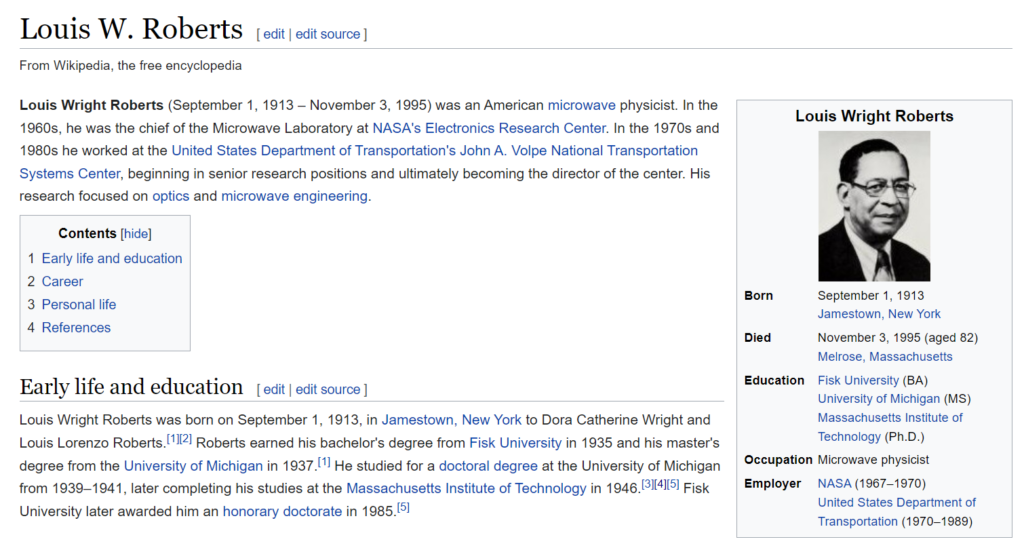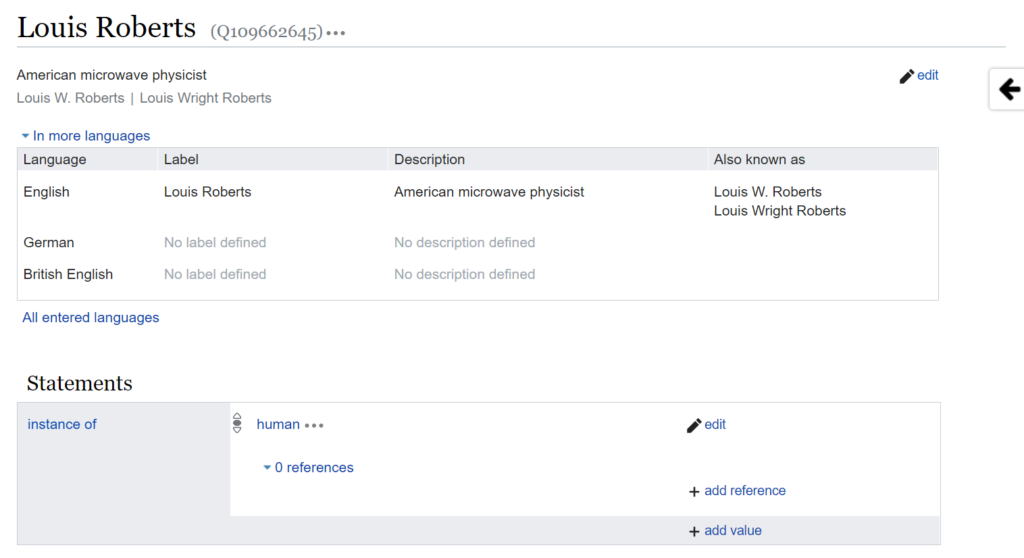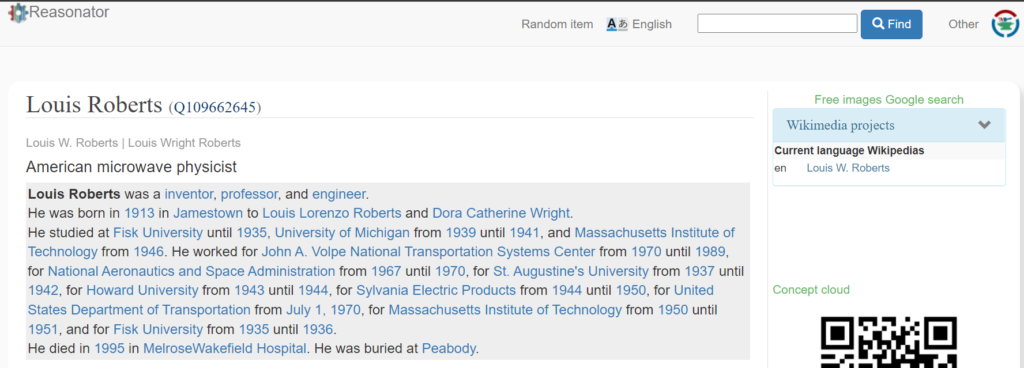Reflection on filling a new Wikidata item
A few days ago I watched a Twitch stream by Molly / GorillaWarfare where they created the Louis W. Roberts English Wikipedia page. I decided to follow along and populate the matching Wikidata item (Q109662645) with as much information as I could from the same references that were being found for the Wikipedia article.
Along the way, I remembered some of the quirks of the manual editing experience for Wikidata and noted some other things that generally might be interesting folks.
This is a write-up of those thoughts.
Louis W. Roberts
Louis featured on a list of African-Americans in Boston having articles created or improved on English Wikipedia. This list was generated from the content of a book called “African-Americans in Boston : more than 350 years” by Hayden, Robert C which can be found on archive.org. Louis is specifically noted on page 149.
This provides some starting context and some good elements to match against other references. From here multiple other references expanding what was known about Louis were found using search engines, Wikipedia library and more. All of which are now included on the Wikipedia and Wikidata pages.
- “Louis Wright Roberts, Dr”. Who’s Who Among African Americans. Gale. 2005.
- Malerbo, Dan (February 11, 2010). “Let’s Talk About: Louis W. Roberts”. Pittsburgh Post-Gazette.
- Department of Transportation and Related Agencies Appropriations for Fiscal Year 1980 (Report). 1979. p. 209.
- “Louis W. Roberts, 82 Physicist, electronics specialist”. The Boston Globe. November 7, 1995. ProQuest 290759206.
- “OBITUARY Dr. Louis W. Roberts, microwave physicist, 82”. The Boston Herald. November 7, 1995. ProQuest 401513033.
- Hayden, Robert C. (1991). African-Americans in Boston: More than 350 Years (2nd ed.). Boston, Massachusetts: Trustees of the Public Library of the City of Boston. p. 149. ISBN 0-89073-083-0.
- “Roberts appointed to NASA”. Bay State Banner. March 14, 1968. ProQuest 371344257.
- Williams, Scott. “Louis W. Roberts”. Physicists of the African Diaspora. State University of New York at Buffalo. Retrieved November 27, 2021.
Wikipedia article formation
Molly started creating the article in their userspace with the first version including a single line of content. This was gradually expanded while looking through the references. This expansion continued during the first hour after which there was enough referenced content to warrant a move to the main namespace. It made sense to keep the article in user space while it was being worked on to avoid unsuspecting readers seeing a work in progress article.
After landing in the main namespace categories were added using the HotCat gadget. The article continued to expand, including more references and categories. A person infobox was added to the article using data already found and stated in the article. Categories were sorted using another user script, and content continued to get added.
A few days after editing by Molly was complete, another user came along and added the Short description template copying the description from the Wikidata item.

Wikidata item population
While following the stream I tried to add roughly the same information to the Wikidata item that was appearing in the Wikipedia article. Molly had already added the first few basic statements to the Item such as instance of, sex or gender, given name, family name, occupation and employer. And the single reference to African-Americans in Boston page 149 already exists on one of the statements.
My first changes added the initial reference to another 2 statements that already existed, and added a new alias matching the Wikipedia article title. I then noticed that the existing employer statement could be more specific per one of the newly found references, so I altered the value and added a new reference.
Date of birth and date of death came next, but I immediately followed up these changes adding some new statements with the preferred rank for some more specific dates that I found in another reference. Also then a reference place of birth.
Many education and employer related changes ensued, followed by a realization that one of the references that I had been copying between statements using a gadget had been copying an incorrect reference that I didn’t want to keep, which I removed.
More content was added, followed by another realization of some incorrect data (the end time was before the start time). I’ll skip over the rest, but many more statements were added and tweaks made.

Comparison
I have a feeling that the creation of the Wikipedia article and Wikidata item would probably have been much more interesting to watch than to read after the fact with a bunch of links to diffs. But you’ll have to cope with my poorly written adventure for context.
Edits & Bytes: The Wikipedia article was fairly complete with around 32 edits, totalling 8k bytes of text storage for the final revision. The Wikidata item was fairly complete after around 114 edits, totalling 71k bytes text storage for the final revision. That’s 3-4x the number of edits as the Wikipedia article, and nearly 10x the number of bytes in the final revision.
References: The Wikipedia article includes a reference list of 8 sources, and these are referenced 34 or so times in the article text. References need only be defined once using a <ref> tag, and can then be referred to by name for subsequent uses. The Wikidata item contains 51 distinct references (no reuse is available) making use of 7 sources on 27 statements.
Wikidata editing quirks
The DuplicateReferences provides copy links next to references that already exist. This is helpful to avoid retyping things when a reference already exists that is the same or very similar to what you want to add. There is also the functionality to drag references from one statement to another (possibly provided by the same gadget). As noted above sometimes the gadget doesn’t quite hit the spot when you want a similar but slightly different reference. You can end up copying things you don’t want, and need to remove them later.
As a long time Wikidata editor I know when to use the rank feature, and what rank means. A couple of edits that I made set a preferred rank leaving some less specific but still referenced values at a normal rank. However, the interface for making this change is not very user friendly and there is no real guidance in the editing flow covering how and when to use this.
When creating some statements that needed references to Items that did not already exist (mother and father), I had to break out of my editing flow to navigate to Special:NewItem in order to create entities to point to. A nicer experience could be to be able to create such Items on the fly while creating a statement.
As the item got longer and longer it got harder to copy references between statements, but also harder to keep an eye on the statements that I had already added so as not to add them again. When complete the Wikidata item was over 4-6 whole heights of my monitor, meaning lots of scrolling back and forth.
Some information ends up duplicated, for example, educated at statements often container a qualifier for academic degree. There can however also be a top-level academic degree statement. The more I thought about this the more I thought that editing Wikidata 1 level higher might be nice, where some other community maintained definitions map higher-level data input to actual statement changes.
Wikidata data in use
Some Wikipedia projects, such as eo.wikipedia.org, have an extension called ArticlePlaceholder enabled. This provides a special page on the Wikipedia that can be found via search results including some information for a given concept, and a prompt to create an article for the topic.

Wikidata and other smaller Wikipedia projects can also link to the Reasonator tool created by Magnus Manske that can give a summary of a topic, and is viewable in multiple languages. Other elements, such as timelines, are also generated in this tool.

Infoboxes are generally used on all Wikipedia sites. We saw above that the current English Wikipedia article uses a manual infobox created by Molly using Infobox Person. There is a Wikidata powered version of this infobox too called Infobox person/Wikidata.
According to the template transclusion count tool this Wikidata powered infobox is currently used only 3.7k times on English Wikipedia.
At the time of writing this, you can find an example of this infobox on the Aelbert Cuyp article. But you can also see a previewed rendering of the Wikidata infobox for the Louis Roberts article in this tweet.
Final thoughts
I really enjoyed watching Molly’s stream editing Wikipedia, I’ll be sure to join again. It’s a great excuse to relax and do some Wikidata editing too.
I’m not really sure how many folks edit individual Wikidata items in this way anymore. The largest numbers of Wikidata edits come from other bulk editing interfaces, or from bots, but that doesn’t mean that high-quality individual editing should not be possible.
Using some napkin maths I’d say that there are generally 400-900k edits per day. Roughly ~60k edits per day come from the Wikidata UI (so ~10%). ~5k edits a day come from changes on client sites such as Wikipedia (so ~1%).
It’d be really nice to connect the workflows of content creation a bit more. The research done when either writing a Wikipedia article or Wikidata item is ultimately the work that we want to be able to easily share between projects. If when editing Wikipedia you could define facts/statements as you went to then be included in Wikidata, I imagine we would reduce effort everywhere and increase reuse of this research across projects.
Good observations Adam. I think lots of small UI tweaks would go a long way to improving things for manually editing using Wikidata’s UI. There is definitely a lot of mouse clicking needed and a more keyboard tabbed navigation could be an optional. Screen real estate is at a premium I would say when editing on Wikidata. One small simple change would be to widen the screen editing space in general that is available. This could be done by having an optional preference for slideout left hand menu, for example. Then qualifiers could actually be made nearly in line with the statement rows, and less scrolling would be needed. There’s a lot to say about any item, and you often only want to work on certain parts of the item at a time, for instance, a Person, you might have tabs for Bio, Education, Work, etc. For an organism, you might even tabs for Characteristics (the 7 characteristics of Life ), Phylogeny, Other. I’d love to eventually see optional UI portions that could be enabled, disabled for those things like slideouts, shown/hidden context, optional tab views for sets of related properties, etc. A split view would also be nice where context is shown on the left side, and the right side has the scrollable, editable data. I.E. more generally a database feel that is context aware and allows switching context when appropriate.
“Screen real estate is at a premium”
The recently-added “compact items” gadget (see “gadgets” tab, under “preferences”, when logged in) makes a vast improvement in this regard.
[…] talks about “sharing workload” which reminds me of some thoughts I recently had comparing Wikipedia and Wikidata editing. Wikibase has a focus on Ecosystem enablement, which I am looking forward to working […]
“another user came along and added the Short description template copying the description from the Wikidata item.”
Because storing duplicated content in multiple venues is so sensible.
But the internet isn’t a normalised database, where integrity can be guaranteed. Might having multiple copies be better than a single source, as in ‘lots of copies keep things safe’? I can’t make my mind up if this argument applies here, or not.
Descriptions, Wikipedia and Wikidata etc is actually something I want to write another blog post about this month!
Yeah, the English war on wikidata including short description, and few wikidata info boxes is a constraint on content creation. Waste of effort because of control issues.
I think data driven content is a great thing and “infobox person/wikdata” is a good example, you are right to note it is not used as much as you’d expect on the English Wikipedia, interestingly some editors really don’t like it, for example there’s one that activity seeks them out, and at at best converts them to static but often just deletes them!